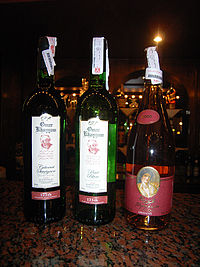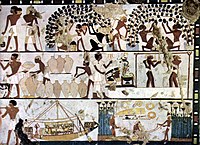Egyptian wine

Winemaking has a long tradition inEgyptdating back to the 3rd millennium BC. The modern wine industry is relatively small scale but there have been significant strides towards reviving the industry. In the late nineties the industry invited international expertise in a bid to improve the quality of Egyptian wine, which used to be known for its poor quality.[1]In recent years Egyptian wines have received some recognition, having won several international awards.[2]In 2013 Egypt produced 4,500 tonnes of wine, ranking54th globally,ahead ofBelgiumand theUnited Kingdom.[3]
Climate
[edit]
High average temperatures and poor rainfall present a major challenge for Egyptian grape producers. To overcome these difficulties vineyards in Egypt apply innovative solutions, such as using pergolas to shade the plants and palm trees to shield them from winds as well as transporting the harvest in refrigerated trucks.[4]
Before the construction of theAswan High Damthe annualflooding of the Nile(Egyptian Arabic:وفاء النيلWafa' El Nil) provided fertile and hydrated soil for the vines, and the stable weather conditions made it a competitive location for the cultivation of wine grapes. After the construction of the dam in 1970 the annual flooding stopped. Today vineyards in Egypt use drip irrigation to make up for the lack of rain.[5]
Grape varieties
[edit]At the time the state-owned Al Ahram Beverages Company was privatized in 1997 all noble grapes that had previously been planted by its subsidiary, Gianaclis Vineyards, were lost. This meant that grapes had to be imported, mainly from Lebanon. This coincided with a boom in the tourism industry which meant wineries had to produce cheap wine in large quantities to meet the surging demand from Western tourists. Due to the lack of locally produced wine grapes wineries imported concentrated juice from Europe which would be diluted with water and fermented, contributing to the negative reputation of Egyptian wine.[2]The Gianaclis Vineyards started planting vines again in 2004 inAlexandriaandLuxor.By 2010 only 2% of their wines were made with Lebanese grapes, with Egyptian grapes used for the remainder of their production.[6]The industry has in recent years started experimenting with international varieties to find grapes that are suited for the Egyptian climate.[5]The main varieties used in red wines areCabernet Sauvignon,Syrah,Grenache,BobalandTempranillo,whileViognier,ChardonnayandMuscatare used for white wines.[7]
Koroum of the Nile, a winery based inEl Gouna,cultivates an indigenous grape variety known as Bannati which is used in its Beausoleil white wine. In 2016 the wine won a silver medal at theInternational Wine ContestinBrussels.[8]The grapes are grown at their vineyard by the Nile in central Egypt, nearBeni Hasan,anancient Egyptiansite.[9]
History
[edit]

Wine was a staple commodity inancient Egypt.[10]It played an important role in ancient Egyptian ceremonial life.[10]A thriving royal winemaking industry was established in theNile Deltafollowing the introduction of grape cultivation from theLevantto Egyptc. 3000BC. The industry was most likely the result of trade between Egypt andCanaanduring the earlyBronze Age,commencing from at least the 27th-century BCThird Dynasty,the beginning of theOld Kingdomperiod. Winemaking scenes on tomb walls, and the offering lists that accompanied them, included wine that was definitely produced in the delta vineyards. By the end of the Old Kingdom, five distinct wines, probably all produced in the Delta, constituted a canonical set of provisions for the afterlife.
Wine in ancient Egypt was predominantlyred.Due to its resemblance to blood, much superstition surrounded wine-drinking inEgyptian culture.Shedeh,the most precious drink in ancient Egypt, is now known to have been a red wine and not fermented frompomegranatesas previously thought.[11]Plutarch'sMoraliarelates that, prior toPsammetichus I,thepharaohsdid not drink wine noroffer it to the gods"thinking it to be the blood of those who had once battled against the gods and from whom, when they had fallen and had become commingled with the earth, they believed vines to have sprung". This was considered to be the reason why drunkenness "drives men out of their senses and crazes them, inasmuch as they are then filled with the blood of their forebears".[12]
Residue from five clayamphorasinTutankhamun's tomb, however, have been shown to be that ofwhite wine,so it was at least available to the Egyptians through trade if not produced domestically.[13]
Winemaking continued to be part of Egyptian culture during Roman rule in Egypt. Christians constituted the majority of Egypt’s population by the 3rd century, despite a reserved attitude towards alcohol in theChurch of Alexandriamonasteries are known have stored and produced large quantities of wine.[14]In 2008 two wine presses dating back to Roman rule in Egypt were unearthed nearSaint Catherine's Monasteryin Sinai, along with ancient coins fromAntioch,which could indicate that Egyptian wine was exported to Christians in the region.[15]
The production of wine declined significantly after theMuslim conquest of Egyptin the 7th century. Attitudes towards alcohol varied greatly under Islamic rule, Muslim rulers generally showed some level of tolerance towards alcohol production controlled by religious minorities. Jewish manuscripts from theCairo Genizarecount the involvement of Egyptian Jews in the production and sale of wine in medieval Egypt.[16]The consumption of wine was not necessarily limited to religious minorities however.[16]Western travelers and pilgrims passing through Cairo on their journeys reported that Muslim locals imbibed on wine and a local barley beer, known as"booza"(Egyptian Arabic:بوظة,not to be confused with theLevantine ice creamof the same name), even during the most draconian periods of Islamic rule.[16]The most popular wine was known as"nebit shamsi"(Egyptian Arabic:نبيذ شمسي), made from imported raisins and honey and left to ferment in the sun (hence the name, which roughly translates into "sun wine" ).[17]
Viticulturewas revived in Egypt by Greek-Egyptian tobacco merchant and entrepreneur,Nestor Gianaclis,who founded the country's first modern vineyard south of Alexandria in 1882.[18]The country's wine industry expanded under the early 20th century, until theEgyptian revolution of 1952which saw the country's liberal monarchy unseated, in favor of a presidential system. In 1963 Egyptian presidentGamal Abdel Nassernationalized and merged breweries and vineyards in the country,[19]under the previously Belgian-owned Pyramid Brewery, which later came to be known as Al Ahram Beverages Company.[20]Mismanagement under state-ownership and an increasingly religious population contributed to the industry's gradual decline. The company was privatized in 1997, at the height of its ruination,[19]part of an economic reform program that sought to restructure the country's economy. This was viewed as a turning-point for the alcohol industry as a whole in Egypt. Its new owner, Egyptian businessmanAhmed Zayat,restructured the company and introduced a line of non-alcoholic beverages that would appeal to the conservative segment of the population. The company was sold toHeineken Internationalin 2002 for $280 million.[19]
See also
[edit]References
[edit]- ^Turtle, Michael (30 May 2014)."Reviving the Nectar of Ancient Egypt".Time Travel Turtle.Retrieved7 November2016.
- ^abFurer, David."Egyptian wine on the way up – Hot climate viticulture is spreading".BKWineMagazine.Retrieved12 November2016.
- ^"Wine production (tons)".Food and Agriculture Organization.6 October 2015. p. 1.Retrieved12 October2016.
- ^Jean-Baptiste, Ancelot (27 June 2014)."Egypt: the vineyards behind the pyramids".the drinks business.
- ^ab"A Vineyard in Egypt".Maadi Messenger.Archived fromthe originalon 21 December 2017.Retrieved8 November2016.
- ^Ramadan, Ahmed (2010)."Wine-making in the Middle East: Egypt".Egypt Independent.Retrieved12 November2016.
- ^"Egyptian Wine Regions".wine-searcher.Retrieved12 November2016.
- ^"Egypt wineries beat the desert and poor reviews to win awards".Middle East Eye.Retrieved13 November2016.
- ^"Selling Egypt's wine to the world".Japan Times. Archived fromthe originalon 15 November 2016.Retrieved12 November2016.
- ^abDzierzbicka, Dorota (2023), Cromwell, Jennifer; Blanke, Louise (eds.),"Monastic Vintages: The Economic Role of Wine in Egyptian Monasteries in the Sixth to Eighth Centuries",Monastic Economies in Late Antique Egypt and Palestine,Cambridge University Press, pp. 129–151,doi:10.1017/9781009278959.006,ISBN978-1-009-27895-9
- ^Maria Rosa Guasch-Jané, Cristina Andrés-Lacueva, Olga Jáuregui and Rosa M. Lamuela-Raventós, The origin of the ancient Egyptian drink Shedeh revealed using LC/MS/MS, Journal of Archaeological Science, Vol 33, Iss 1, Jan. 2006, pp. 98–101.
- ^"Isis & Osiris".University of Chicago.
- ^White wine turns up in King Tutankhamen's tomb.USA Today,29 May2006.
- ^Lundhaug, Hugo (2015).The Monastic Origins of the Nag Hammadi Codices.Mohr Siebeck. p. 122.ISBN9783161541728.
- ^Bossone, Andrew."Ancient Christian" Holy Wine "Factory Found in Egypt".National Geographic.Archived fromthe originalon November 7, 2016.Retrieved6 November2016.
- ^abcLewicka, Paulina (2005).Restaurants, Inns and Taverns That Never Were: Some Reflections on Public Consumption in Medieval Cairo.BRILL. pp. 71, 66, 85.
{{cite book}}:|periodical=ignored (help) - ^Lewicka, Paulina (2011).Food and Foodways of Medieval Cairenes: Aspects of Life in an Islamic Metropolis of the Eastern Mediterranean.BRILL. p. 495.ISBN9789004194724.
- ^"Gianaclis: The History and Heritage of Gianaclis Wines in Egypt".Cairo 360.Retrieved7 November2016.
- ^abcTeeter, Adam."The Non-Alcoholic Beer That Fueled American Pharoah's Triple Crown Victory".Vinepair.Retrieved7 November2016.
- ^"About ABC - History".Al Ahram Beverages.Retrieved7 November2016.
